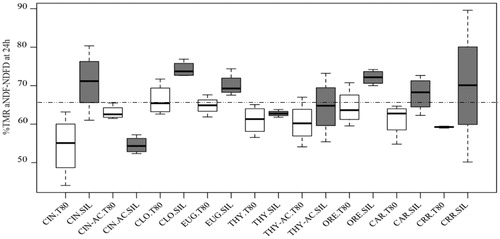Figures & data
Table 1. Chemical composition and digestibility of the substrates employed in the study.
Table 2. Effect of carriers and phytochemicals (PCs) essential oils (EO) and essential oils active compounds (EOAC) on in vitro dry matter (DM) digestibility (%) of maize meal, soybean meal and total mixed ration (TMR) at 4 and 24 h of fermentation.
Figure 1. Boxplot comparing the effects across all combination between phytochemicals (PC) and carrier on maize meal dry matter digestibility (DMD) at 4 h of fermentation. The white boxes express the DMD distribution affected by the PC emulsified (T80), while the grey boxes express the DMD distribution affected by the PC adsorbed on silica (SIL). No outliers were detected then no points of values were plotted individually. The horizontal line in the middle indicates the median of the sample, the top and the bottom of the rectangle (box) represents the 75th and 25th percentiles. The whiskers at either side of the rectangle represent the lower and upper quartile. The dotted line represents the substrate digestibility. Treatments combinations: CIN = cinnamon oil, CIN-AC = cinnamaldehyde, CLO = clove oil, EUG = eugenol, THY = thyme oil, THY-AC = thymol, ORE = oregano oil, CAR = carvacrol, CRR = negative control (substrate plus carrier), T80 = Tween 80, SIL = Silica.
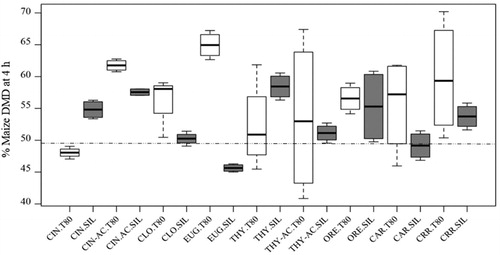
Figure 2. Boxplot comparing the effects across all combination between phytochemicals (PC) and carrier on maize meal dry matter digestibility (DMD) at 24 h of fermentation. The white boxes express the DMD distribution affected by the PC emulsified (T80), while the grey boxes express the DMD distribution affected by the PC adsorbed on silica (SIL). No outliers were detected then no points of values were plotted individually. The horizontal line in the middle indicates the median of the sample, the top and the bottom of the rectangle (box) represents the 75th and 25th percentiles. The whiskers at either side of the rectangle represent the lower and upper quartile. The dotted line represents the substrate digestibility. Treatments combinations: CIN = cinnamon oil, CIN-AC = cinnamaldehyde, CLO = clove oil, EUG = eugenol, THY = thyme oil, THY-AC = thymol, ORE = oregano oil, CAR = carvacrol, CRR = negative control (substrate plus carrier), T80 = Tween 80, SIL = Silica.
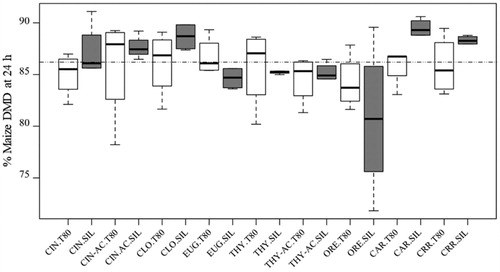
Figure 3. Boxplot comparing the effects across all combination between phytochemicals (PC) and carrier on soybean meal dry matter digestibility (DMD) at 4 h of fermentation. The white boxes express the DMD distribution affected by the PC emulsified (T80), while the grey boxes express the DMD distribution affected by the PC adsorbed on silica (SIL). No outliers were detected then no points of values were plotted individually. The horizontal line in the middle indicates the median of the sample, the top and the bottom of the rectangle (box) represents the 75th and 25th percentiles. The whiskers at either side of the rectangle represent the lower and upper quartile. The dotted line represent the substrate digestibility. Treatments combinations: CIN = cinnamon oil, CIN-AC = cinnamaldehyde, CLO = clove oil, EUG = eugenol, THY = thyme oil, THY-AC = thymol, ORE = oregano oil, CAR = carvacrol, CRR = negative control (substrate plus carrier), T80 = Tween 80, SIL = Silica.

Figure 4. Boxplot comparing the effects across all combination between phytochemicals (PC) and carrier on soybean meal dry matter digestibility (DMD) at 24 h of fermentation. The white boxes express the DMD distribution affected by the PC emulsified (T80), while the grey boxes express the DMD distribution affected by the PC adsorbed on silica (SIL). No outliers were detected then no points of values were plotted individually. The horizontal line in the middle indicates the median of the sample, the top and the bottom of the rectangle (box) represents the 75th and 25th percentiles. The whiskers at either side of the rectangle represent the lower and upper quartile. The dotted line represents the substrate digestibility. Treatments combinations: CIN = cinnamon oil, CIN-AC = cinnamaldehyde, CLO = clove oil, EUG = eugenol, THY = thyme oil, THY-AC = thymol, ORE = oregano oil, CAR = carvacrol, CRR = negative control (substrate plus carrier), T80 = Tween 80, SIL = Silica.

Figure 5. Boxplot comparing the effects across all combination between phytochemicals (PC) and carrier on total mixed ration (TMR) dry matter digestibility (DMD) at 4 h of fermentation. The white boxes express the DMD distribution affected by the PC emulsified (T80), while the grey boxes express the DMD distribution affected by the PC adsorbed on silica (SIL). No outliers were detected then no points of values were plotted individually. The horizontal line in the middle indicates the median of the sample, the top and the bottom of the rectangle (box) represents the 75th and 25th percentiles. The whiskers at either side of the rectangle represent the lower and upper quartile. The dotted line represents the substrate digestibility. Treatments combinations: CIN = cinnamon oil, CIN-AC = cinnamaldehyde, CLO = clove oil, EUG = eugenol, THY = thyme oil, THY-AC = thymol, ORE = oregano oil, CAR = carvacrol, CRR = negative control (substrate plus carrier), T80 = Tween 80, SIL = Silica.
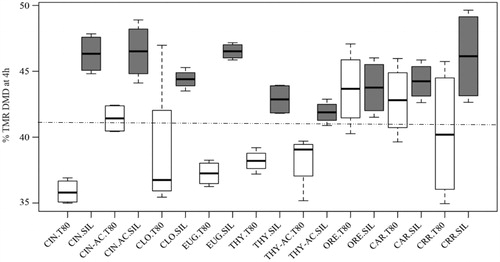
Figure 6. Boxplot comparing the effects across all combination between phytochemicals (PC) and carrier on total mixed ration (TMR) dry matter digestibility (DMD) at 24 h of fermentation. The white boxes express the DMD distribution affected by the PC emulsified (T80), while the grey boxes express the DMD distribution affected by the PC adsorbed on silica (SIL). No outliers were detected then no points of values were plotted individually. The horizontal line in the middle indicates the median of the sample, the top and the bottom of the rectangle (box) represents the 75th and 25th percentiles. The whiskers at either side of the rectangle represent the lower and upper quartile. The dotted line represents the substrate digestibility. Treatments combinations: CIN = cinnamon oil, CIN-AC = cinnamaldehyde, CLO = clove oil, EUG = eugenol, THY = thyme oil, THY-AC = thymol, ORE = oregano oil, CAR = carvacrol, CRR = negative control (substrate plus carrier), T80 = Tween 80, SIL = Silica.

Table 3. Effect of carriers and phytochemicals (PCs) essential oils (EO) and essential oils active compounds (EOAC) on in vitro neutral detergent fibre (NDF) digestibility (%) of maize meal, soybean meal and total mixed ration (TMR) at 4 and 24 h of fermentation.
Figure 7. Boxplot comparing the effects across all combination between phytochemicals (PC) and carrier on maize meal neutral detergent fibre digestibility (NDFD) at 4 h of fermentation. The white boxes express the NDFD distribution affected by the PC emulsified (T80), while the grey boxes express the NDFD distribution affected by the PC adsorbed on silica (SIL). No outliers were detected then no points of values were plotted individually. The horizontal line in the middle indicates the median of the sample, the top and the bottom of the rectangle (box) represents the 75th and 25th percentiles. The whiskers at either side of the rectangle represent the lower and upper quartile. The dotted line represent the substrate digestibility. Treatments combinations: CIN = cinnamon oil, CIN-AC = cinnamaldehyde, CLO = clove oil, EUG = eugenol, THY = thyme oil, THY-AC = thymol, ORE = oregano oil, CAR = carvacrol, CRR = negative control (substrate plus carrier), T80 = Tween 80, SIL = Silica.
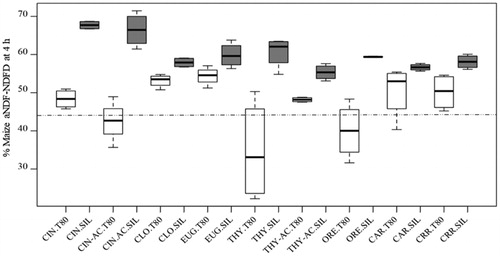
Figure 8. Boxplot comparing the effects across all combination between phytochemicals (PC) and carrier on maize meal neutral detergent fibre digestibility (NDFD) at 24 h of fermentation. The white boxes express the NDFD distribution affected by the PC emulsified (T80), while the grey boxes express the NDFD distribution affected by the PC adsorbed on silica (SIL). No outliers were detected then no points of values were plotted individually. The horizontal line in the middle indicates the median of the sample, the top and the bottom of the rectangle (box) represents the 75th and 25th percentiles. The whiskers at either side of the rectangle represent the lower and upper quartile. The dotted line represent the substrate digestibility. Treatments combinations: CIN = cinnamon oil, CIN-AC = cinnamaldehyde, CLO = clove oil, EUG = eugenol, THY = thyme oil, THY-AC = thymol, ORE = oregano oil, CAR = carvacrol, CRR = negative control (substrate plus carrier), T80 = Tween 80, SIL = Silica.

Figure 9. Boxplot comparing the effects across all combination between phytochemicals (PC) and carrier on soybean meal neutral detergent fibre digestibility (NDFD) at 4 h of fermentation. The white boxes express the NDFD distribution affected by the PC emulsified (T80), while the grey boxes express the NDFD distribution affected by the PC adsorbed on silica (SIL). No outliers were detected then no points of values were plotted individually. The horizontal line in the middle indicates the median of the sample, the top and the bottom of the rectangle (box) represents the 75th and 25th percentiles. The whiskers at either side of the rectangle represent the lower and upper quartile. The dotted line represents the substrate digestibility. Treatments combinations: CIN = cinnamon oil, CIN-AC = cinnamaldehyde, CLO = clove oil, EUG = eugenol, THY = thyme oil, THY-AC = thymol, ORE = oregano oil, CAR = carvacrol, CRR = negative control (substrate plus carrier), T80 = Tween 80, SIL = Silica.
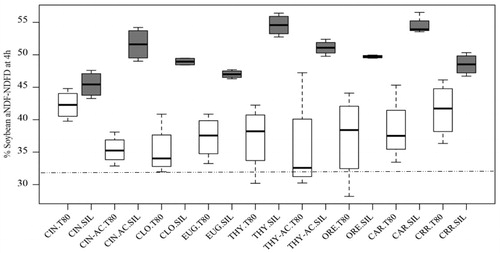
Figure 10. Boxplot comparing the effects across all combination between phytochemicals (PC) and carrier on soybean meal neutral detergent fibre digestibility (NDFD) at 24 h of fermentation. The white boxes express the NDFD distribution affected by the PC emulsified (T80), while the grey boxes express the NDFD distribution affected by the PC adsorbed on silica (SIL). No outliers were detected then no points of values were plotted individually. The horizontal line in the middle indicates the median of the sample, the top and the bottom of the rectangle (box) represents the 75th and 25th percentiles. The whiskers at either side of the rectangle represent the lower and upper quartile. The dotted line represents the substrate digestibility. Treatments combinations: CIN = cinnamon oil, CIN-AC = cinnamaldehyde, CLO = clove oil, EUG = eugenol, THY = thyme oil, THY-AC = thymol, ORE = oregano oil, CAR = carvacrol, CRR = negative control (substrate plus carrier), T80 = Tween 80, SIL = Silica.
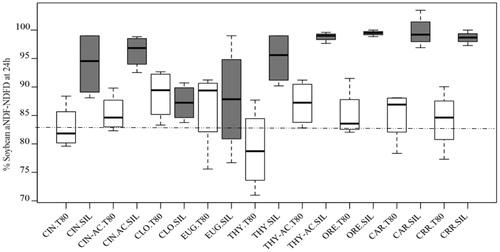
Figure 11. Boxplot comparing the effects across all combination between phytochemicals (PC) and carrier on total mixed ration (TMR) neutral detergent fibre digestibility (NDFD) at 4 h of fermentation. The white boxes express the NDFD distribution affected by the PC emulsified (T80), while the grey boxes express the NDFD distribution affected by the PC adsorbed on silica (SIL). No outliers were detected then no points of values were plotted individually. The horizontal line in the middle indicates the median of the sample, the top and the bottom of the rectangle (box) represents the 75th and 25th percentiles. The whiskers at either side of the rectangle represent the lower and upper quartile. The dotted line represents the substrate digestibility. Treatments combinations: CIN = cinnamon oil, CIN-AC = cinnamaldehyde, CLO = clove oil, EUG = eugenol, THY = thyme oil, THY-AC = thymol, ORE = oregano oil, CAR = carvacrol, CRR = negative control (substrate plus carrier), T80 = Tween 80, SIL = Silica.
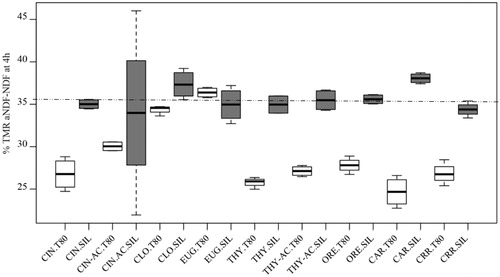
Figure 12. Boxplot comparing the effects across all combination between phytochemicals (PC) and carrier on total mixed ration (TMR) neutral detergent fibre digestibility (NDFD) at 24 h of fermentation. The white boxes express the NDFD distribution affected by the PC emulsified (T80), while the grey boxes express the NDFD distribution affected by the PC adsorbed on silica (SIL). No outliers were detected then no points of values were plotted individually. The horizontal line in the middle indicates the median of the sample, the top and the bottom of the rectangle (box) represents the 75th and 25th percentiles. The whiskers at either side of the rectangle represent the lower and upper quartile. The dotted line represents the substrate digestibility. Treatments combinations: CIN = cinnamon oil, CIN-AC = cinnamaldehyde, CLO = clove oil, EUG = eugenol, THY = thyme oil, THY-AC = thymol, ORE = oregano oil, CAR = carvacrol, CRR = negative control (substrate plus carrier), T80 = Tween 80, SIL = Silica.
